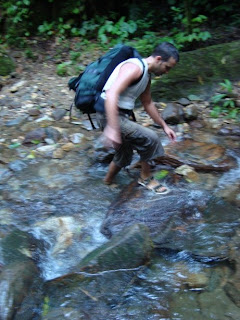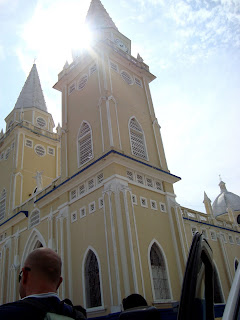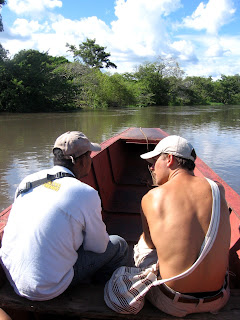Rundown: A three day uphill trek into the Sierra Nevada mountains through jungles, rivers and native villages to spend two days at a site of an ancient city reclaimed by nature before a three day return trip. Please don't feed the guerillas.
Took a bus north from Cartagena to a city on the coast called Santa Marta, a cross between a beach town and a port, with a beautiful island guarding the harbor and ocean freighters swinging on their moorings right next to kids splashing in the waves.

Spent the night in a dodgy hotel, and in the morning met up with the rest of the group going. Edwin was our guide (the same guide whose group was abducted by ELN guerillas in 2003, and then returned safely), and along with the four other teachers, we had 3 Brits, 3 Germans, 2 Sweeds, an Italian and a Croatian. It was quite a pleasure to get to know everyone along the way.
Took a chiva (cross between a bus and a jeep, without real doors or sides and painted in garish colors) into the interior. Drove for an hour on tarmac, and then spent another two off road climbing into the Sierra Nevada Mountains, often stopping to let people out to hang on appropriate sides of the chiva to keep it from rolling over going over aggressive terrain.


The chiva dropped us off in a little pueblo in the foothills where we began our three day hike. We hiked through the red-dirt foothills up into the jungle, crossing a couple low rivers on the way. Awesome trekking.


Made it to our first encampment just after dark, winding down steep, muddy switchbacks that claimed a few shoes as victims. Check out the little video of the hiking bit of the trek.
The encampment was an open air shelter with a corrugated metal roof under which we slung our cloth hammocks and bug nets. Although we did get bitten, the onslaught was nothing like a June evening in Michigan.


Swam in the morning at the watering hole and played with the resident friendly toucan.


Hiked all the next day in dense jungle, across rivers, and through native Kogui villages where they speak only their indigenous language, and little or no Spanish.


Hiked through dense jungle and high mountian savanna. Up ridges and down valleys... Edwin made us framiliar with the Coca plant that has been so integral to Colombia's history.


Passed a night in our second encampment which was perched about the beautiful and powerful Rio Buritaca. We stayed dry in the heavy rain that night.



Our final day up to the Lost City, we hiked for a few hours, pausing to rest our beaten, bug-gnawed legs, and chow on our daily fresh fruit on massive jungle leaves.


Made five river crossings. The rivers were powerful enough that even though we waded only to our waists, the water was enough warrant linking arms to cross. Fun stuff.


We found ourselves on a rocky island in the middle of the river. On the far side, the earth took a near-vertical leap; the jungle foliage just holding on. Tucked just inside the shadow of the trees, ancient stone steps wove their way up the mountain and disappeared in the brush. We crossed the river and took the stairs.


Most of the steps were no bigger than a shoebox, mossy, and slick, but not in bad shape considering their thousand years of service in harsh jungle climate. An hour and two thousand steps later we emerged (sweaty and wheezing) out of the jungle and onto the first of many stone terraces left by the Tairona people.

The site was a religious center, built into the mountains to communicate with the gods. Five main terraces stuck out of the dense jungle, but thousands of other terraces, some still buried in vegetation, were connected by stone pathways crisscrossing throughout the steep terrain. The site was only ‘discovered’ in 1976, so along the paths, stone steps would disappear into the underbrush, still uncovered.


We stayed the night there and listened to Edwin’s account of being taken by the ELN (similar to the FARC only in that they tote guns, hang out in the jungle, and have their own political agenda). The accomodations included 7 mattresses laid out on the floor with a huge bug net over them on the second floor of an open air shelter. I felt a bit like I was 8 again, making forts with my sisters out of pillows and blankets.

Due to the ease to which any armed group could pluck travelers off of the mountain side, a company of Colombian soldiers were stationed at Ciudad Perdida and in the surrounding hills. They patroled the site with their Israeli arms, but were extremely happy to talk to anyone.


Spent two days at the site wandering around the winding stone paths and swimming in the waterfalls before our return trek. The site was novel, interesting, and beatuiful, but wasn't a place to trek to if one isn't into getting muddy and having a little bit of struggle. As with all my treks, the people and the journey were the best part.

And one little video to cap it off with the theme song of the trip.
.





















